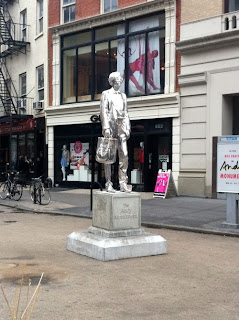Feed Your Head: Design and the Elastic Mind at MoMA (A Review)
 A few months ago, when I read that a certain type of printer was capable of producing three-dimensional objects, I had a hard time getting my head around the idea that I could print out a lost toothbrush. I completely forgot about the invention until I came across some of the printed objects in MoMA's new head-blowing exhibit, Design and the Elastic Mind. Now that I better understand the technology that allows me to print out an attractive bowl for the table - it involves resin and layers, I think I want a 3D printer in the worst way.
A few months ago, when I read that a certain type of printer was capable of producing three-dimensional objects, I had a hard time getting my head around the idea that I could print out a lost toothbrush. I completely forgot about the invention until I came across some of the printed objects in MoMA's new head-blowing exhibit, Design and the Elastic Mind. Now that I better understand the technology that allows me to print out an attractive bowl for the table - it involves resin and layers, I think I want a 3D printer in the worst way.The exhibit at MoMA, some of it interactive, does toy a bit with this sort of high-tech consumer fetishism, but its deeper motive is to explain the more profound intersection of design and science through the lens of "elasticity." Defined in the exhibit as "the product of adaptability plus acceleration," elasticity implies movement - soaring arcs between shimmering points of light, walls that bend, micro-organisms that grow and change in relation to passersby, organisms capable of carrying information or broadcasting images in motion, prosthetic ankles that walk like real ones.
As an active organism in the blogosphere, I am already well-versed in the art of virtual mapping, an intermediate player in Google mashups, and familiar enough with tag clouds to appreciate the structuralist fundamentals of analyzing my own language. The exhibit covers some of the brave new frontiers of the web in its section on "Harvesting the Internet." We're already moved past those items, however, as it's so elastic. Check out what's in your future at Google Labs.
While I'm fine with the Internet, in terms of appreciating the virtual frontiers of computing, it's the biological parts of the Design exhibit that give me pause. In nanotechnology, scientists and designers are working in various fields to visualize or engineer revolutionary processes at the molecular level. Researchers at Harvard have visualized the "inner life of the cell" to give students aesthetically pleasing cinematic renderings of cellular life, and surely, pretty pictures could lead to more successful recruitment for future majors in the sciences. Maybe these students will go on to design video games that track down and kill cancer cells in the body. That would be wonderful.
Contemporary visual culture, as an academic field, embraces the notion that we're hell-bound to visualize that which we previously thought could not be made visible. Our global culture, in turning from the text toward the image, produces pictures that suggest their own ineffability, their own inarticulate "Wow." Nevertheless, Design and the Elastic Mind, while showing the much dazzling "wow" of macro and micro design and science, reveals that we still depend on those old and fabulous bits of information that we call "words" to explain these wonders. Or vice versa. I loved looking at Brad Paley/Text Arc's structuralist visualizations for Alice in Wonderland and trying to glean the relationship of the words to the cosmic rabbit hole.
Happily, the exhibit's online site is terrific and awaits exploration. Explore it here for yourself. Be prepared for lots of WORDS.
Design and the Electric Mind continues at the Museum of Modern Art through May 12, 2008.
At top: Screen capture of Google Analytics map showing locations of visitors to Walking Off the Big Apple during the month of February 2008. Click to enlarge.





Comments
Post a Comment